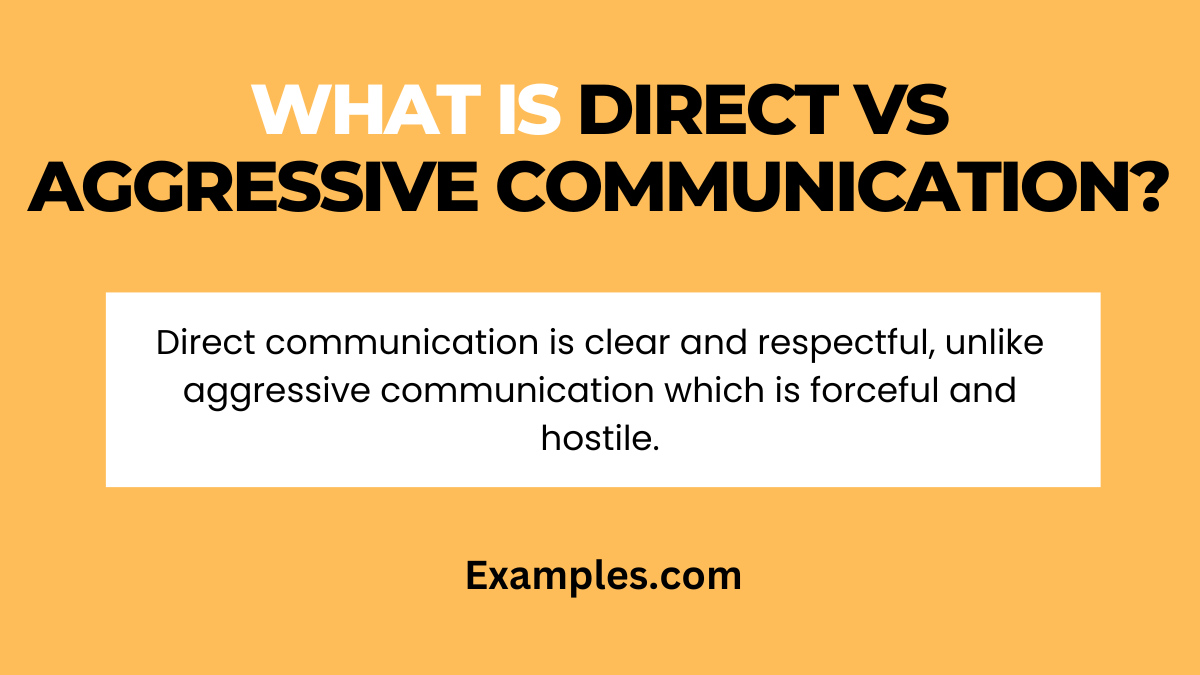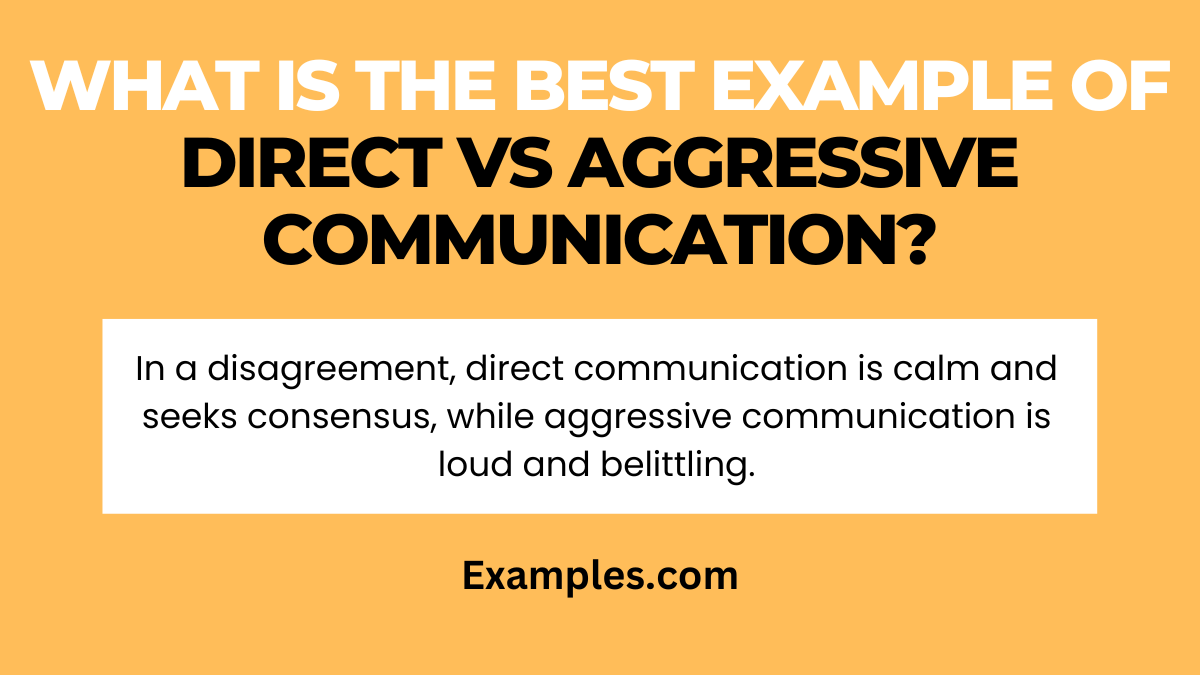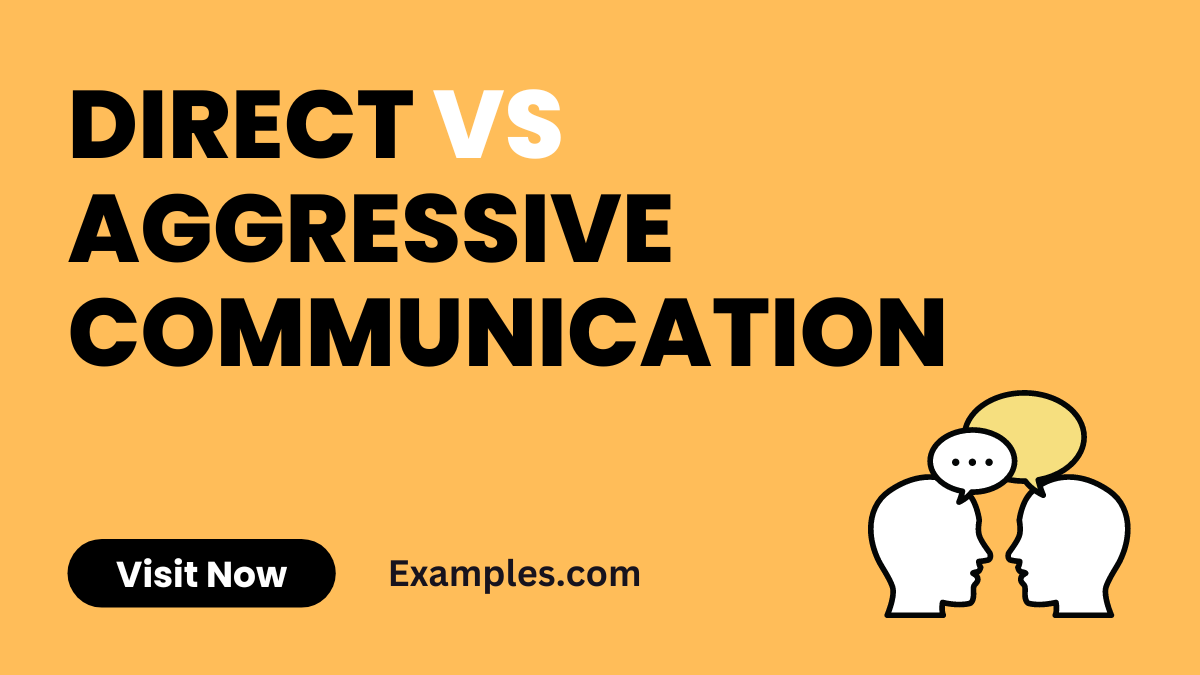Direct vs Aggressive Communication – 9+ Examples
Oral communication plays a vital role in our interactions, but the manner in which we express ourselves can greatly impact the outcomes. This comprehensive guide delves into aggressive communication, exploring examples, characteristics, and communication styles. It also highlights why aggressive communication is detrimental and offers insights into dealing with it effectively. Discover the distinctions between direct and aggressive communication and gain a deeper understanding of this crucial aspect of human interaction.
What is Direct vs Aggressive Communication?

Direct communication involves clear and straightforward expression of thoughts and feelings while maintaining respect for others. It promotes open dialogue and effective interaction. In contrast, aggressive communication is forceful, disrespectful, and often hostile, aiming to dominate or intimidate others.
What is the Best Example of Direct vs Aggressive Communication?

Imagine a scenario where a disagreement arises in a team meeting. In direct communication, an individual calmly expresses their viewpoint, listens to others, and seeks common ground. In contrast, aggressive communication may involve shouting, interrupting others, and using derogatory language to belittle opposing views.
Difference Between Direct vs Aggressive Communication

When it comes to interpersonal communication, understanding the difference between direct and aggressive styles is crucial. Below is a table highlighting ten key aspects that set them apart:
| Aspect | Direct Communication | Aggressive Communication |
|---|---|---|
| Tone of Voice | Respectful and clear | Hostile and confrontational |
| Intent | Honest and constructive | Demeaning and hurtful |
| Expressing Opinions | Confidently and openly | Insensitively and rudely |
| Conflict Resolution | Problem-solving | Blame-shifting and anger |
| Body Language | Open and engaged | Closed-off and threatening |
| Listening | Actively and empathetically | Selectively or not at all |
| Feedback Delivery | Constructive and helpful | Destructive and hurtful |
| Respect for Boundaries | Acknowledges boundaries | Disregards boundaries |
| Emotional Impact on Others | Positive and supportive | Negative and harmful |
| Desired Outcome | Mutual understanding | Power and control |
10 Examples of Direct Communication
Direct communication is clear, straightforward, and effective. Here are 10 unique examples:
- In a Meeting: “Let’s discuss the project timeline and goals.”
- Explanation: This statement directly addresses the purpose of the meeting.
- Giving Instructions: “Please complete the report by Friday.”
- Explanation: Clear and concise instructions leave no room for ambiguity.
- Expressing Needs: “I need your help with the presentation.”
- Explanation: Articulating a specific need promotes effective collaboration.
- Feedback: “Your input on the proposal was valuable.”
- Explanation: Expressing appreciation for contributions encourages positive interactions.
- Making a Request: “Could you pass me the salt, please?”
- Explanation: A polite request seeks a specific action.
- Setting Boundaries: “I prefer not to discuss my personal life at work.”
- Explanation: Clearly stating personal boundaries helps maintain professionalism.
- Apologizing: “I’m sorry for my mistake in the report.”
- Explanation: A direct apology acknowledges responsibility for an error.
- Expressing Feelings: “I’m excited about the upcoming event.”
- Explanation: Sharing feelings openly fosters emotional connection.
- Expressing Agreement: “I agree with your proposal.”
- Explanation: A straightforward agreement indicates consensus.
- Declining Politely: “I appreciate the offer, but I can’t attend.”
- Explanation: A polite decline maintains respect while conveying unavailability.
10 Examples of Aggressive Communication
Aggressive communication can be harmful and hurtful. Here are 10 distinct examples:
- Direct Confrontation: “You’re wrong, and I’m right! End of discussion!”
- Explanation: Using forceful language to dominate a conversation.
- Intimidation Tactics: “You better do what I say, or else!”
- Explanation: Employing threats to control others.
- Manipulation: “If you cared about me, you’d do what I want.”
- Explanation: Using emotional manipulation to get one’s way.
- Verbal Attacks: “You’re so incompetent; you can’t do anything right!”
- Explanation: Using insults and personal attacks to demean someone.
- Impatience and Interruption: “Why are you talking? I’m not finished!”
- Explanation: Constantly interrupting and displaying impatience.
- Sarcasm and Mockery: “Oh, great job! You’re a real genius.”
- Explanation: Using sarcasm to belittle and mock others.
- Blame and Accusation: “This mess is all your fault!”
- Explanation: Accusing and blaming without considering facts.
- Overbearing Behavior: “I don’t care what you think; I know best.”
- Explanation: Displaying arrogance and disregard for others’ opinions.
- Hostile Body Language: Eye-rolling, crossed arms, and aggressive gestures.
- Explanation: Non-verbal cues that convey aggression and hostility.
- Dismissive Attitude: “You’re not worth my time; I’m done talking to you.”
- Explanation: Ignoring and dismissing others as unworthy of attention.
Comparison Between Aggressive and Conservative Communication:
- Communication Style: Aggressive communication is characterized by forcefulness and a lack of regard for others’ feelings, while conservative communication focuses on diplomacy and respect.
- Tone and Volume: Aggressive communication often involves loud, confrontational tones, whereas conservative communication maintains a calm and measured demeanor.
- Conflict Resolution: Aggressive communication tends to escalate conflicts, while conservative communication seeks peaceful resolution.
- Listening: Conservative communication prioritizes active listening, whereas aggressive communication often dismisses others’ perspectives.
- Respect: Conservative communication shows respect for differing opinions, whereas aggressive communication can be disrespectful and dismissive.
- Body Language: Aggressive communication may involve intimidating body language, while conservative communication promotes open and approachable body language.
- Goal: Aggressive communication aims to dominate or win, while conservative communication seeks understanding and cooperation.
- Effect on Others: Aggressive communication can alienate and provoke negative reactions, while conservative communication fosters positive interactions.
- Long-Term Impact: Conservative communication builds better relationships over time, whereas aggressive communication may harm them.
- Adaptability: Conservative communication is adaptable to various situations, while aggressive communication can be inflexible.
Relationship Between Aggressive and Conservative Communication:
- Contrasting Styles: Aggressive and conservative communication styles differ significantly in tone, approach, and impact on relationships.
- Conflict Resolution: Conservative communication often leads to better conflict resolution and promotes healthier relationships compared to the confrontational nature of aggressive communication.
- Communication Effectiveness: The choice between these styles can significantly influence the effectiveness of interpersonal communication within relationships.
- Respect and Empathy: Conservative communication emphasizes respect and empathy, enhancing understanding and trust, whereas aggressive communication tends to erode them.
- Long-Term Outcomes: A pattern of aggressive communication can lead to the deterioration of relationships, while conservative communication contributes to their growth and sustainability.
- Adaptability: Depending on the circumstances, individuals may choose either style, but understanding the relationship between them is crucial for effective communication.
- Conflict Resolution: Conservative communication’s focus on compromise and understanding is more conducive to resolving conflicts constructively.
- Communication Patterns: Recognizing the patterns of aggressive and conservative communication can help individuals navigate their relationships more effectively.
- Communication Skills: Developing conservative communication skills can lead to more positive interactions and stronger connections with others.
- Personal Growth: Choosing conservative communication over aggression can contribute to personal growth and improved relationship dynamics.
Understanding the differences between direct and aggressive communication is essential for effective interpersonal interactions. While direct communication is characterized by clarity and assertiveness, aggressive communication tends to be confrontational and harmful. By adopting direct and respectful communication, individuals can express their needs and opinions while maintaining healthy relationships and resolving conflicts constructively. Choosing a direct yet non-aggressive approach fosters understanding, trust, and positive outcomes in both personal and professional settings.



